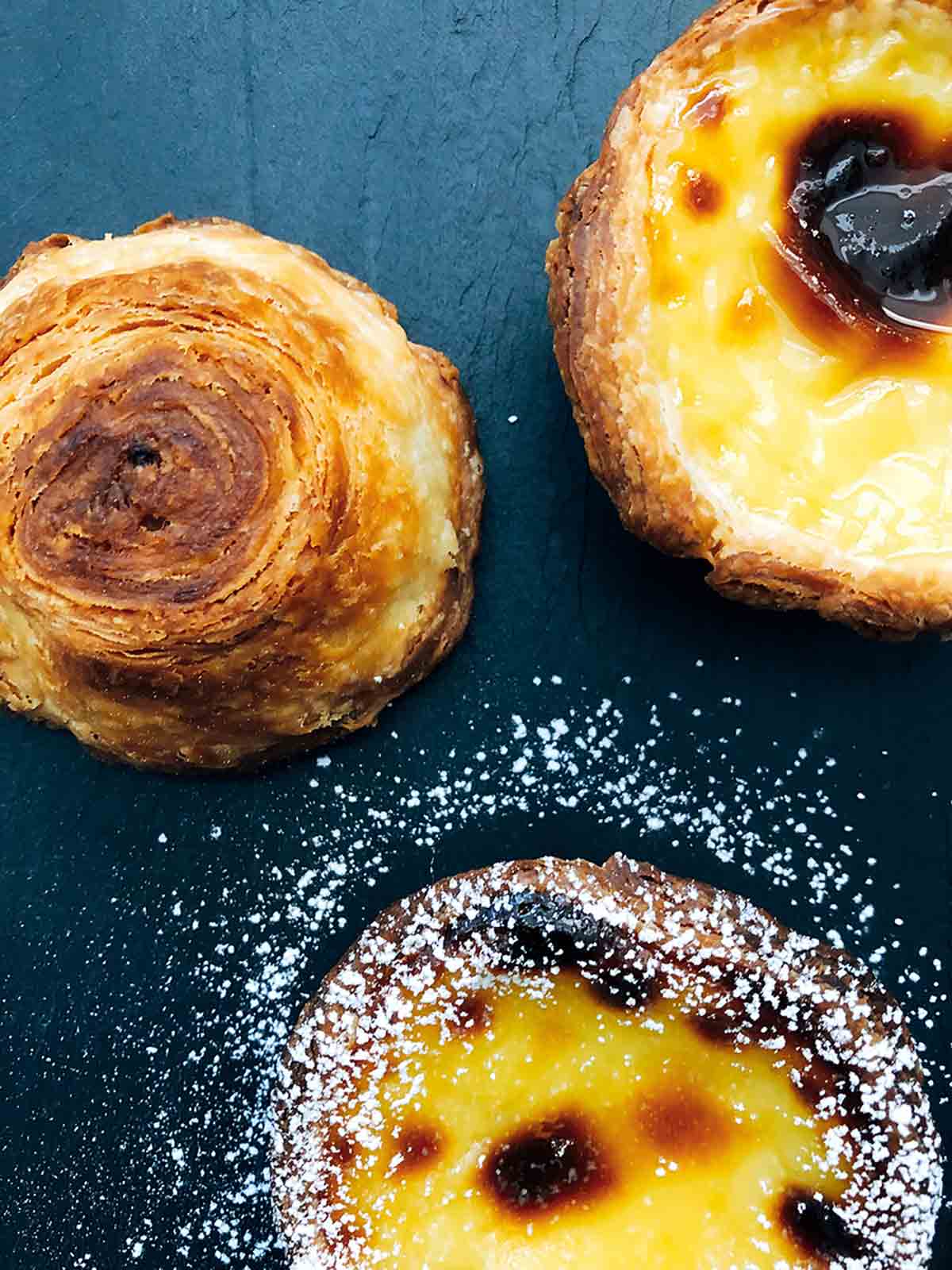
This post was updated on Jan 6, 2025, to include more answers to questions and technique info.
Jump To
Captain Ahab had the great white whale. I have the pastel de nata–the famous Portuguese egg tart. This little pastry has dogged me for years, taunting me, daring me to figure out its secret.
My quest started when I reported about them for the Los Angeles Times more than 20 years ago. Since then, I even visited the Antiga Confeitaria de Belém—three times!—where pasteis de Belem been sold since 1837.
The recipe has been a close-guarded secret for 187 years! Only six people know it, and they all meet behind locked doors to make both the custard and pastry dough. (Yes, they’re serious about their pasteis, my friend.) No matter what, I couldn’t get into that room.
Still, as I skulked around the confeitaria’s kitchens, I picked up some clues: the consistency of the uncooked custard, the texture and stretch of the pastry dough, the technique for making the pastry shells. (It’s all in the thumbs.)
All those clues and observations have been added to this recipe over the years. And it seems to have helped! It’s been shared on social media more than 65,000 times and has been mimicked (*cough* “ripped off”) by just about as many food bloggers. And I have it on good authority that a certain British judge on a certain British baking show used my recipe as the basis for a baking challenge. (I can’t hide it; I’m wicked flattered!)
Still, I’m working diligently, tweaking this recipe so that it comes as close as possible to the original.
So, dear Reader, meet the Queen of all Portuguese Pastries. My Queen, meet Dear Reader. My work here is done!
Chow,

Read: The History of the Pastel de Nata

Why This Recipe Works
This custard tart recipe works for several reasons. First, size matters. In Belem, the tarts are large, and the ovens blast at blistering-hot 800°F (400°C). By making the tarts smaller, they bake perfectly in a home oven. Then there’s the sugar syrup. Cooking the syrup to the precise temperature of 220°F (104°C) ensures the custard sets perfectly. Last, the folding and rolling of the dough gives you that shatteringly crisp spiral of countless layers.
What’s a Pastel de Nata?
Pasteis de nata are devilishly luscious Portuguese custard tarts made with flaky pastry shells filled with rich egg-yolk custard. They were first made by monks at Lisbon’s Jerónimos Monastery sometime before 1834.
Like many Portuguese convent sweets, these tarts made use of surplus egg yolks, as egg whites were used for various purposes throughout Portugal, including starching clothes and clarifying wine.
The custard is poured into spiraled shells made from spiraled dough, similar to puff pastry, and baked until the tarts develop dark caramelized spots on top. They’re served warm with a dusting of cinnamon and powdered sugar. Alas, sadly for us, the original recipe remains a secret at the Antiga Confeitaria de Belém, where they’ve been sold since 1837.
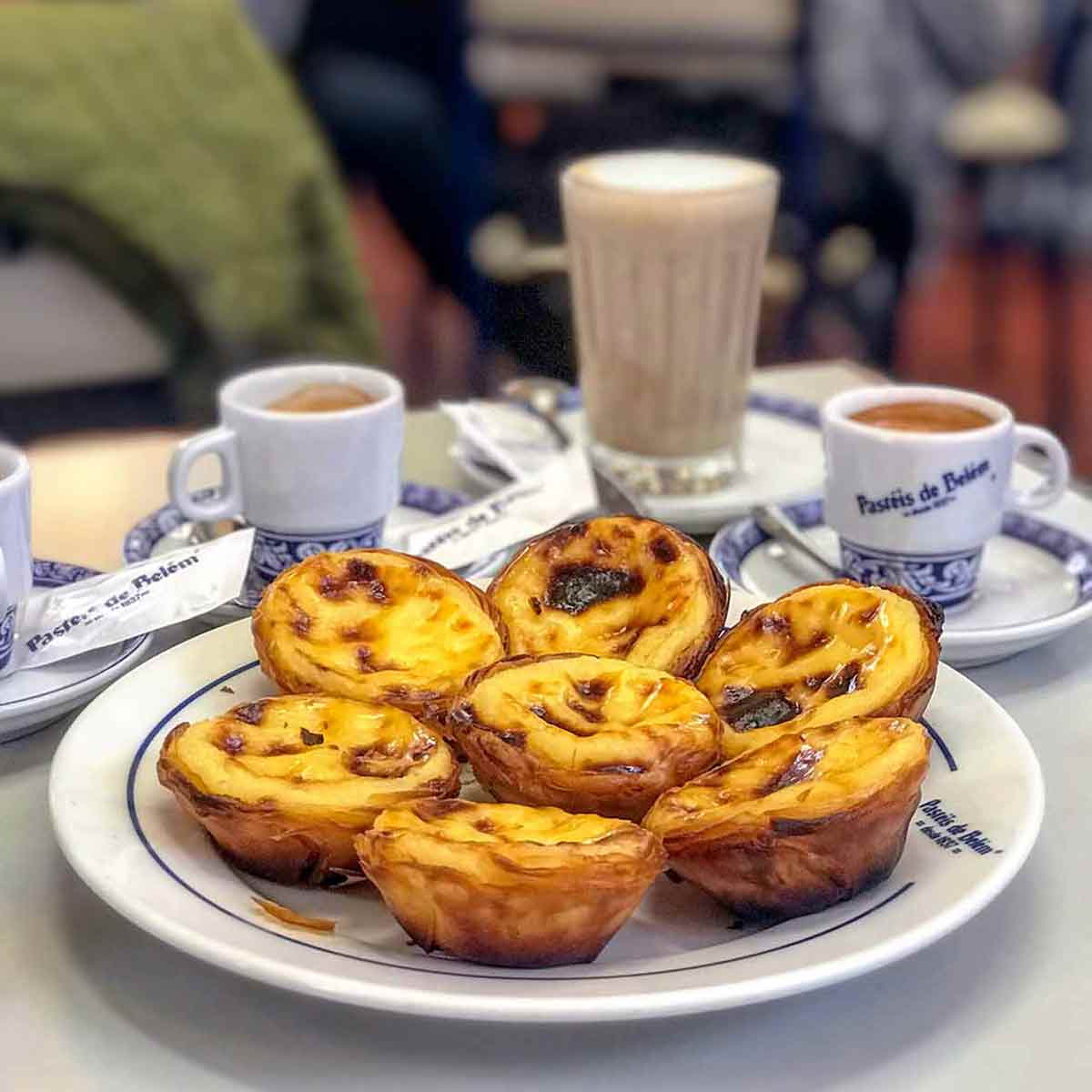
How to Serve Pasteis de Nata
Serve these delightful custard tarts warm, ideally fresh from the oven. Dust them generously with powdered sugar and cinnamon—this is the traditional way. The perfect temperature brings out the contrast between the crispy, flaky pastry and the creamy custard filling.
They’re fantastic with uma bica, Portugal’s answer to espresso. Or you could opt for my favorite, un galão—a tall glass filled with a shot of coffee and lots of milk and foam, kinda like a caffè latte.
Common Questions
1. What’s the difference between pastel de nata and pasteis de nata?
Great question! I know it can seem confusing. Pastel de nata is a single pastry, while pasteis de nata are several tarts. Basically, pasteis is the plural of pastel.
2. How can I get those mottled black spots on top of a pastel?

Ah, the eternal question! I’ve tried all kinds of techniques to get those burnt patches on top. I baked the custard on the highest rack of the oven. I heated a baking steel and slid the pastries underneath. I even broiled them, and none gave me the “look.”
I found the only reliable way to get those beautiful spots on top is to use a convection oven (or the fan setting in European ovens).
Storage & Reheating
- Up to 24 hours, cover them loosely with plastic wrap at room temperature, though the pastry may soften.
- For longer storage, pop them in an airtight container in the fridge for up to 3 days, but beware, the pastry will definitely lose its crispness.
- Freezing? Nope. I don’t recommend it, as it can change the custard texture and make the pastry tough.
- To reheat, warm them in a 350°F (175°C) oven for 5 to 7 minutes. Nix the microwave; it makes them soggy. Blech.
Pro Tips for Pastel de Nata
- When making the pastry, make sure the butter is evenly layered, all excess flour is removed, and the dough is rolled very thin and folded neatly.
- As for the egg tart custard, you’ll need a thermometer to gauge the custard accurately.
- These are best eaten warm the day they’re made.
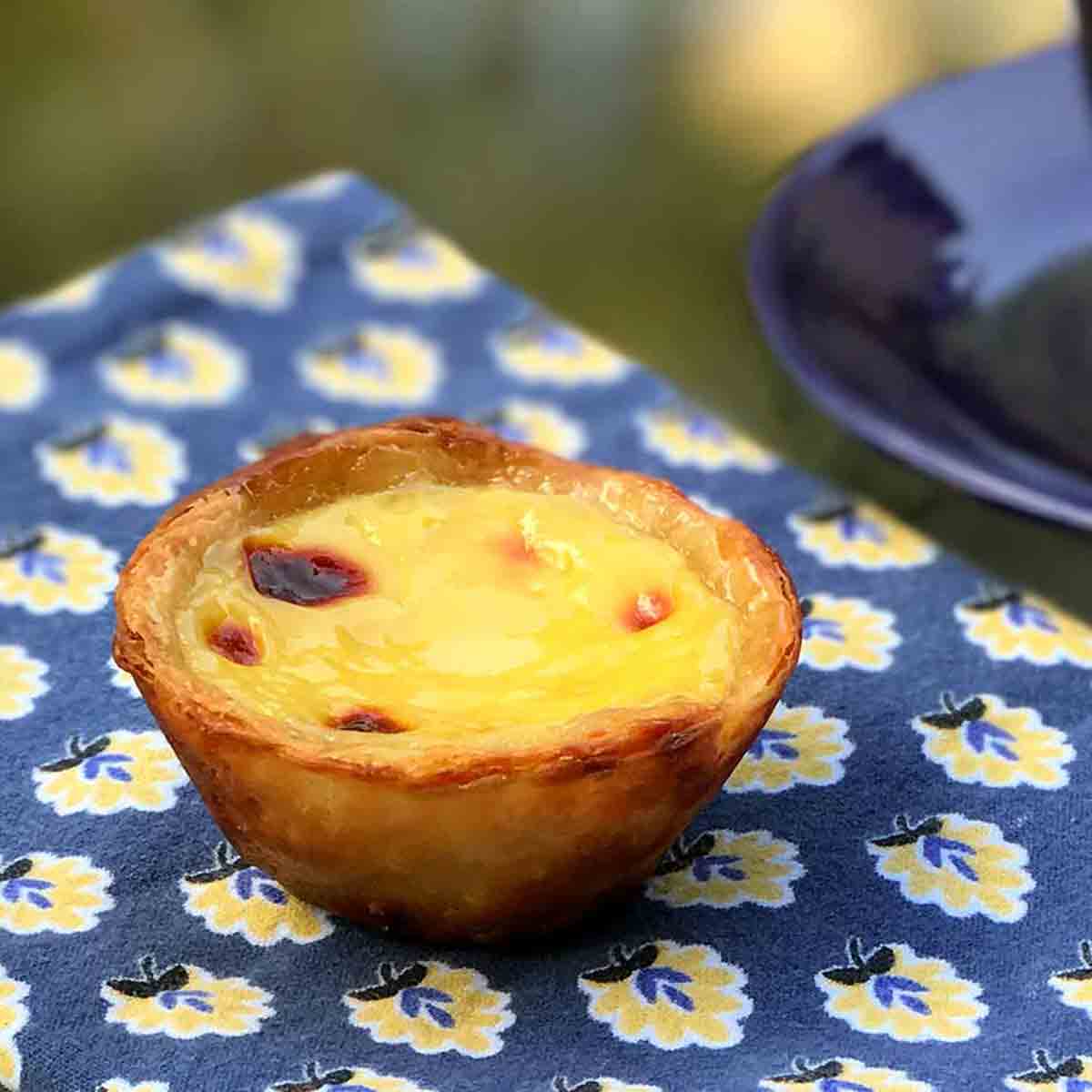
Write a Review
If you make this recipe, or any dish on LC, consider leaving a review, a star rating, and your best photo in the comments below. I love hearing from you.–David
Fantastic recipe, David! Outstanding reviews, and hands down the most positive comments I’ve ever heard from my neighbours and family! Thank you so much, however, now my neighbours are begging for more from me!? LOL! Such a shame to be so popular with your amazing recipe, I suppose it’s a burden that I must bear! Seriously, David, you knocked it put of the park!!
Carrots and Cream Cheese
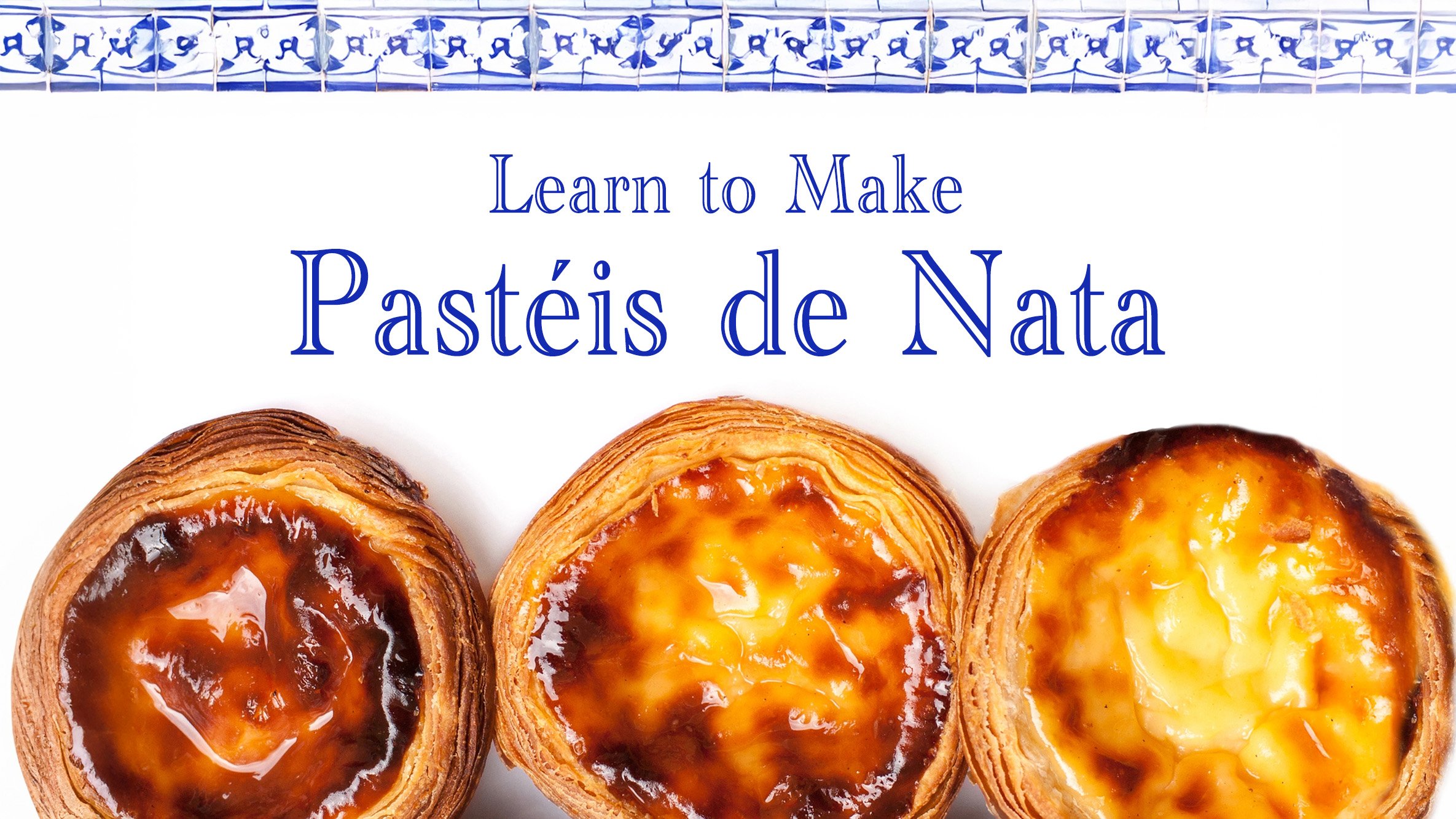
Well, bakers, I finally did it. I improved on my pastel de nata recipe. I took me the better part of a year, but I crafted a recipe that 1.) is way easier to make (none of that endless rolling), 2.) has a creamer, foolproof custard that doesn’t curdle, 3.) sports more frilly, crispy layers, and 4.) can be frozen and enjoyed whenever your heart desires.
Get the replay of the 3-hour class, equipment list, shopping list, recipe, exclusive access to a community of avid bakers, plus monthly 1-hour complimentary live video chats with me.
Video: How to Make Pasteis de Nata
The delightful and charming London pastry queen Cupcake Jemma uses my pastel recipe to make delicious custard tarts.
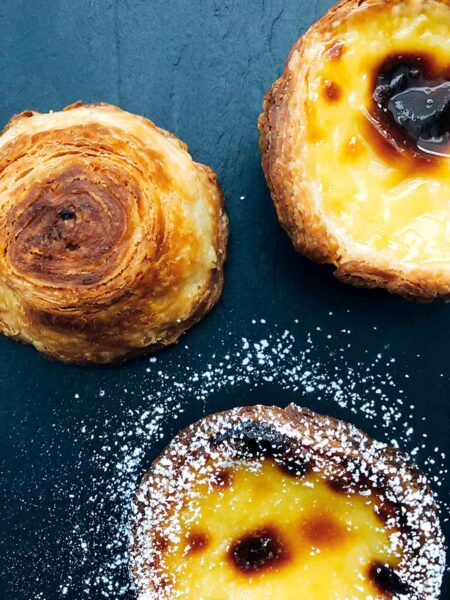
Pasteis de Nata ~ Portuguese Custard Tarts
Equipment
- 1 Mini-muffin tin or…
Ingredients
For the pastel de nata dough
- 2 cups minus 2 tablespoons all-purpose flour, plus more for the work surface
- 1/4 teaspoon sea salt
- 3/4 cup plus 2 tablespoons cold water
- 2 sticks (8 oz) unsalted butter, room temperature, stirred until smooth
For the custard
- 3 tablespoons all-purpose flour
- 1 1/4 cups whole milk, divided
- 1 1/3 cups granulated sugar
- 1 cinnamon stick
- 2/3 cup water
- 1/2 teaspoon vanilla extract
- 6 large egg yolks, whisked
For the garnish
- confectioners' sugar
- ground cinnamon
Instructions
Make the pastel de nata dough
- In a stand mixer fitted with a dough hook, mix the 2 cups minus 2 tablespoons all-purpose flour, 1/4 teaspoon sea salt, and 3/4 cup plus 2 tablespoons cold water until a soft, pillowy dough forms that pulls away from the side of the bowl, about 30 seconds.
- Generously flour a work surface and pat the dough into a 6-inch (15-cm) square using a pastry scraper. Flour the dough, cover with plastic wrap, and let it rest at room temperature for 15 minutes.
- Roll the dough into an 18-inch (46-cm) square. As you work, use the scraper to lift the dough to make sure the underside isn't sticking to your work surface.
- Brush the excess flour off the top of the dough, trim any uneven edges, and, using a small offset spatula, dot and then spread the left 2/3 portion of the dough with a little less than 1/3 of the 2 sticks (8 oz) unsalted butter being careful to leave a 1 inch (25 mm) plain border around the edge of the dough.
- Neatly fold the unbuttered right 1/3 of the dough (using the pastry scraper to loosen it if it sticks) over the rest of the dough. Brush off any excess flour, then fold over the left 1/3 of the dough. Starting from the top, pat down the dough with your hand to release any air bubbles, and then pinch the edges of the dough to seal. Brush off any excess flour.
- Turn the dough 90° to the left so the fold is facing you. Lift the dough and flour the work surface. Once again roll it out to an 18-inch (46-cm) square, then dot the left 2/3 of the dough with 1/3 of the butter and smear it over the dough. Fold the dough as directed in steps 4 and 5.
- For the last rolling, turn the dough 90° to the left and roll out the dough to an 18-by-21-inch (46-by-53-cm) rectangle, with the shorter side facing you. Spread the remaining butter over the entire surface of the dough.
- Using the spatula as an aid, lift the edge of dough closest to you and roll the dough away from you into a tight log, brushing the excess flour from the underside as you go. Trim the ends and cut the log in half. Wrap each piece in plastic wrap and chill for 2 hours or preferably overnight. (The pastry can be frozen for up to 3 months.)
Make the custard
- In a medium bowl, whisk the 3 tablespoons all-purpose flour and 1/4 cup of the milk (60 ml) until smooth.
- Bring the 1 1/3 cups granulated sugar, 1 cinnamon stick, and 2/3 cup water to a boil in a small saucepan and cook until an instant-read thermometer registers 220°F (104°C). Do not stir.
- Meanwhile, in another small saucepan, scald the remaining 1 cup milk (237 ml). Whisk the hot milk into the flour mixture.
- Remove the cinnamon stick and then pour the sugar syrup in a thin stream into the hot milk-and-flour mixture, whisking briskly. Add the 1/2 teaspoon vanilla extract and stir for a minute until very warm but not hot.
- Whisk in the 6 large egg yolks, strain the mixture into a bowl, cover with plastic wrap, and set aside. The custard will be thin; that is as it should be. (You can refrigerate the custard for up to 3 days.)
Assemble and bake the pastries
- Place an oven rack in the top third position and crank the oven to 550°F (290°C) for at least 30 minutes. The oven needs this time to maintain this blazing hot temperature.
- Remove a pastry log from the refrigerator and roll it back and forth on a lightly floured surface until it's about an inch (25 mm) in diameter and 16 inches (41 cm) long. Cut it into scant 3/4-inch (18-mm) pieces. Place 1 piece pastry dough, cut side down, in each well of a nonstick 12-cup mini-muffin pan (2-by-5/8-inch [50-by-15-mm] size).
☞ TESTER TIP: If using classic egg tart tins, cut the dough into generous 1-inch (25-mm) pieces. Allow the dough pieces to soften for several minutes until pliable.
- Have a small cup of water nearby. Dip your thumbs in the water, then straight down into the middle of the dough spiral. Flatten it against the bottom of the cup to a thickness of about 1/16 inch (1.5 mm), then smooth the dough up the sides and create a raised lip about 1/8 inch (3 mm) above the pan. The pastry bottoms should be thinner than the tops.
- Fill each cup 3/4 full with the cool custard. Bake the pastries until the edges of the dough are frilled and brown, about 8 to 9 minutes for the mini-muffin tins, 15 to 17 minutes for the classic tins.
- Remove from the oven and allow the egg tarts to cool a few minutes in the pan, then transfer to a rack and cool until just warm. Sprinkle the pasteis generously with confectioners' sugar, then ground cinnamon and serve. Repeat with the remaining pastry and custard. These are best consumed the day they're made.
Notes
- Pastry making–When making the pastry, make sure the butter is evenly layered, all excess flour is removed, and the dough is rolled very thin and folded neatly.
- Tending to the custard–You’ll need a thermometer to gauge the custard accurately.
- Timing–Portuguese egg tarts are best eaten warm the day they’re made.
Variation
If you’d like a citrus kiss to your custard, add two 2-inch lemon peels along with the cinnamon stick in step 10.
An LC Original
View More Original RecipesNutrition
Nutrition information is automatically calculated, so should only be used as an approximation.
Recipe Testers’ Reviews
According to my Portuguese dad, I can make these pasteis de nata again and again and again! I am pretty chuffed with how they turned out since I had doubts throughout the entire process of making these traditional tarts. First of all, pasteis de nata are the epitome of the classic Portuguese sweet treat. So, no pressure!
In following the recipe, when mixing the flour, salt, and water in the stand mixer, my dough never achieved the soft pillowy stage I was hoping, or rather thinking, what it would be. My dough did pull away from the sides slightly but remained sticky; hence I feel I should have added more flour, which I didn’t at this stage.
Doubt started to set in! When working with the dough on the work surface, I needed to add a very generous amount of flour to stop the dough from sticking. At this stage, I probably added so much flour that I actually increased the amount of flour added to the dough significantly.
I found working with the dough a test of extreme patience! I remained calm (yet doubtful) and just kept working with it gently. I was never able to achieve the 18-by-18-inch square, no matter how hard I tried. It was closer to 14 inches.
The custard seemed quite thin, and even though the recipe mentioned it would be, I had my doubts it would firm up into a creamy custard.
While the tarts baked, the butter bubbled and oozed out of the dough and over the edge of the minis tin, causing lots of smoke in the extremely hot oven. I baked the minis for 9 minutes, and the custard was set, and the pastry was golden brown. I expected the custard to have a brown-speckled appearance (like the ones you buy commercially), but it remained an eggy yellow. For the larger tins, I baked the tarts for 15 minutes, and they, too, remained an eggy yellow with a golden brown pasty.
To my surprise, the pastry was super flaky and crispy, and it had that perfect crackly crunch that is the true mark of a great pastel de pata! And the custard? It set and was creamy, sweet, and deliciously perfect.
When my Portuguese mom said they tasted just like the pasteis de Belem (the most famous and original Portuguese custard tarts), then I knew we had a winner!
Talk about the best compliment ever! It was quite a bit of work to produce these little gems, but the end result was definitely worth the effort!
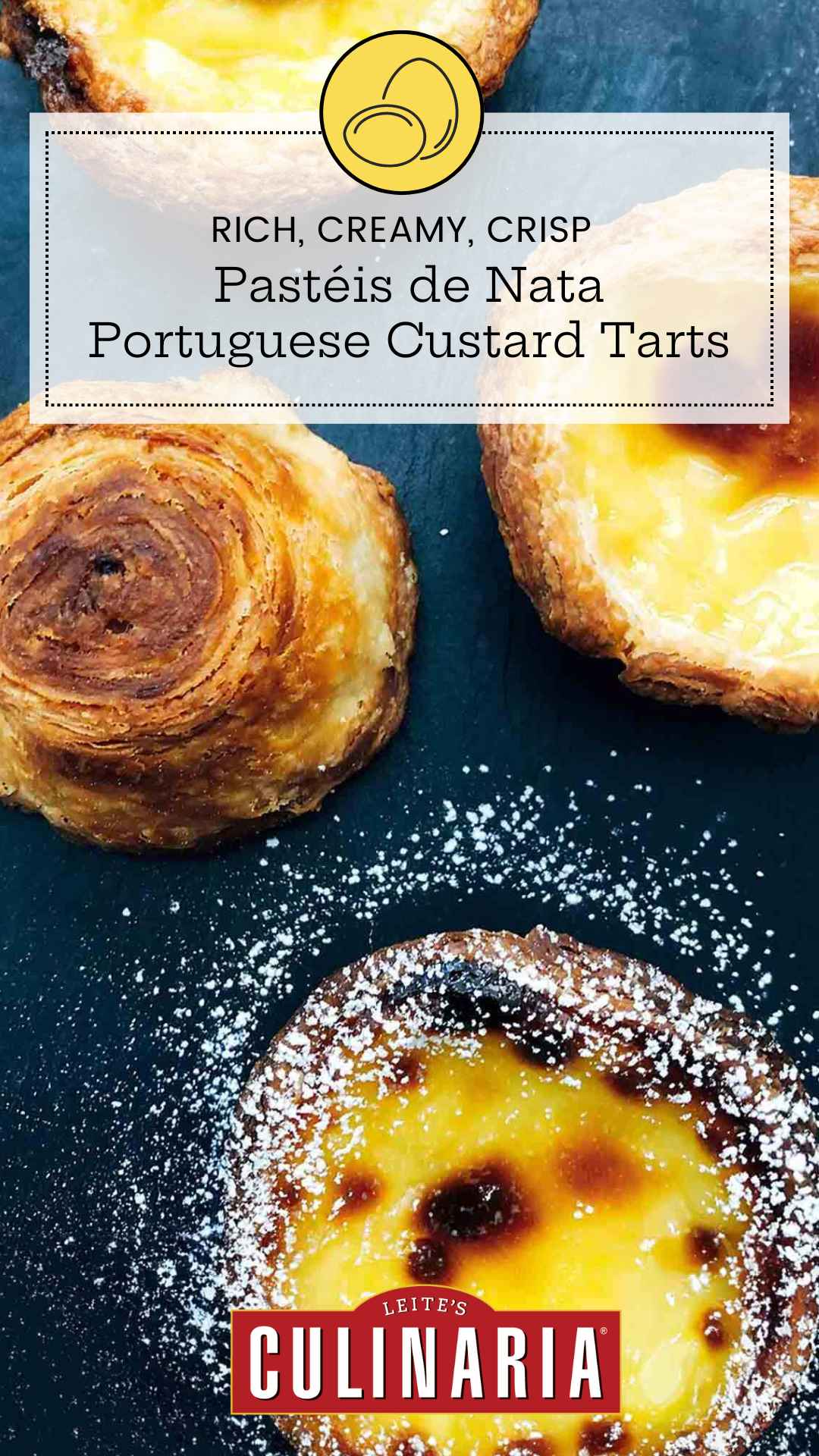
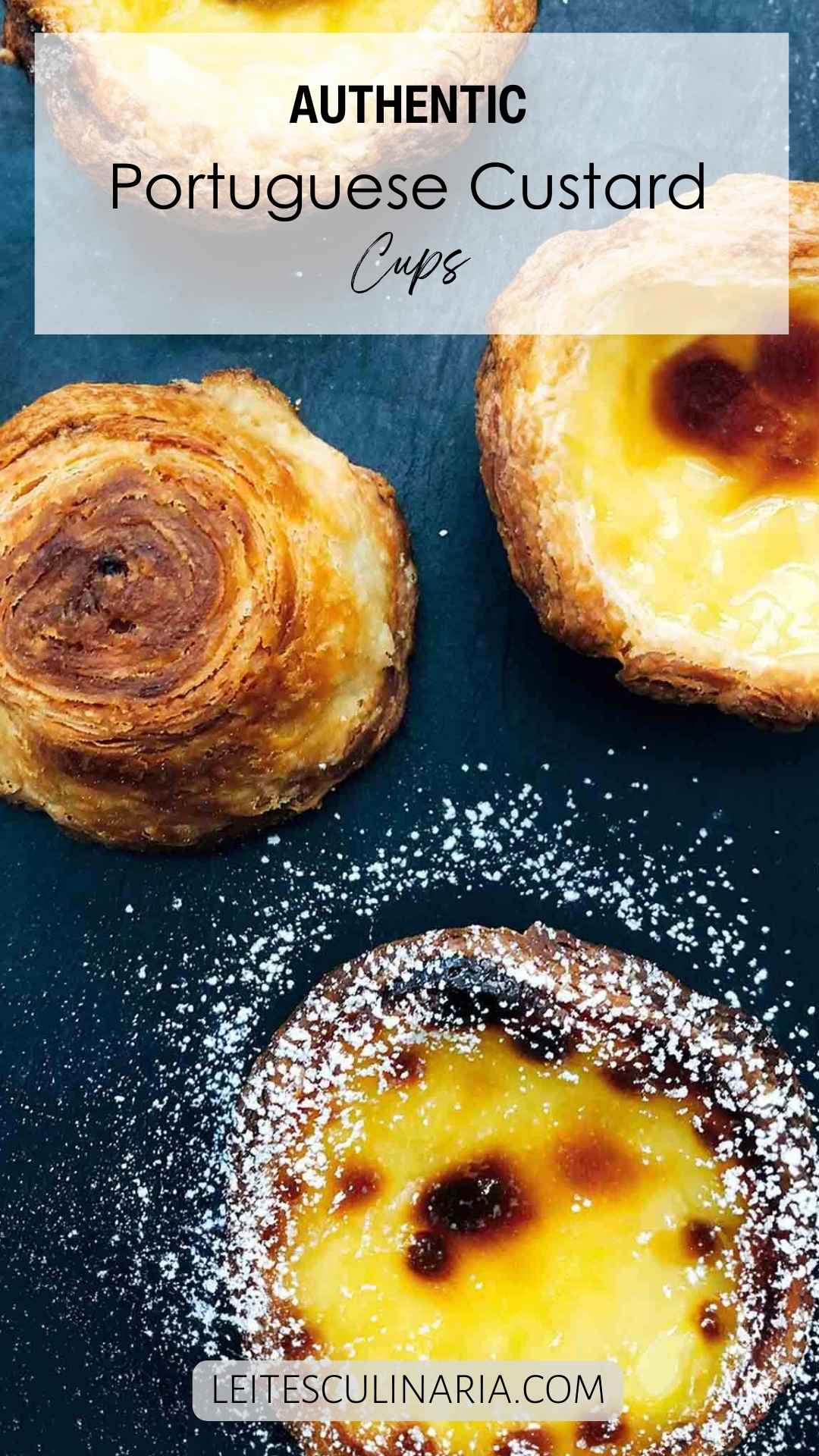
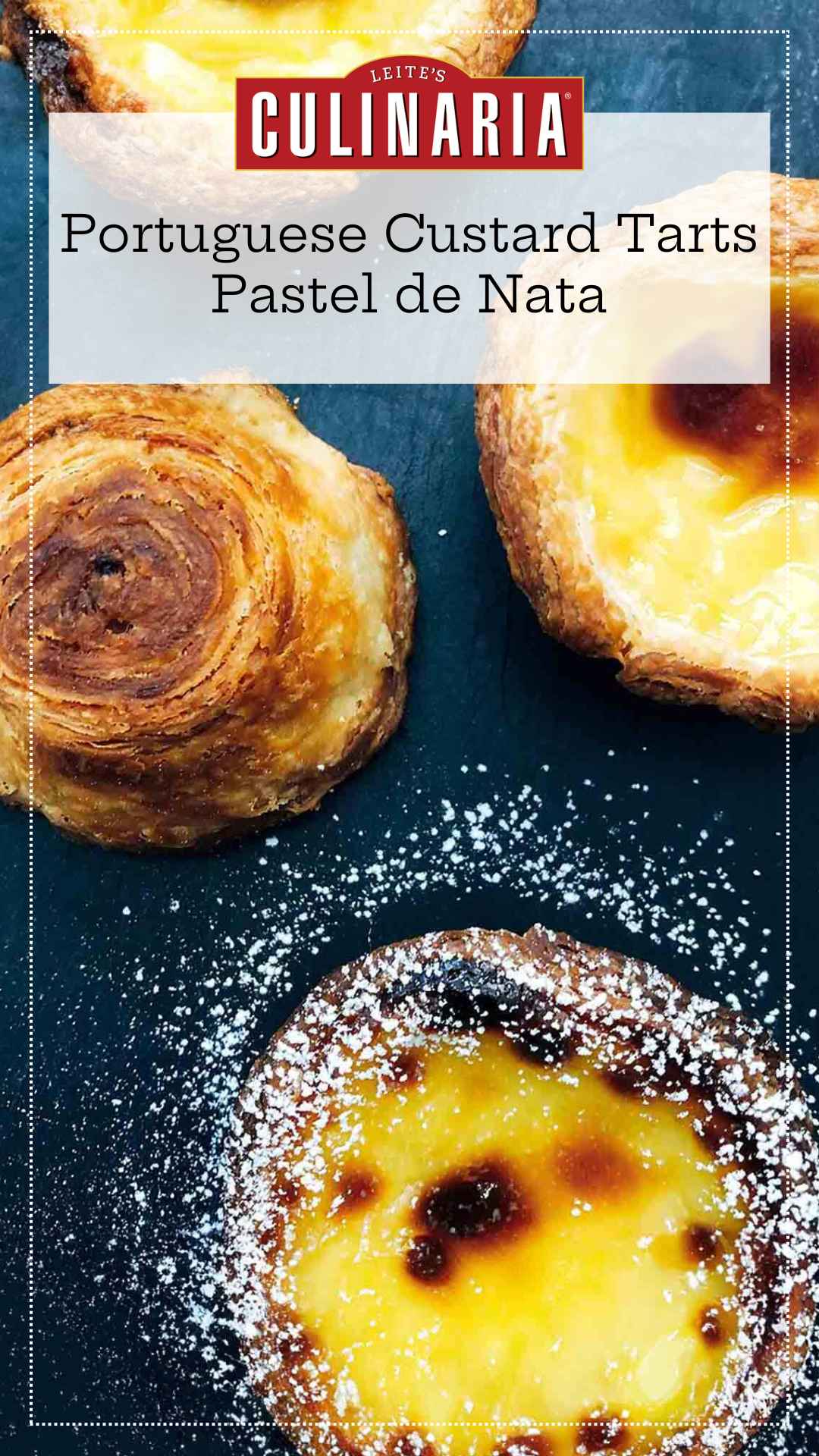
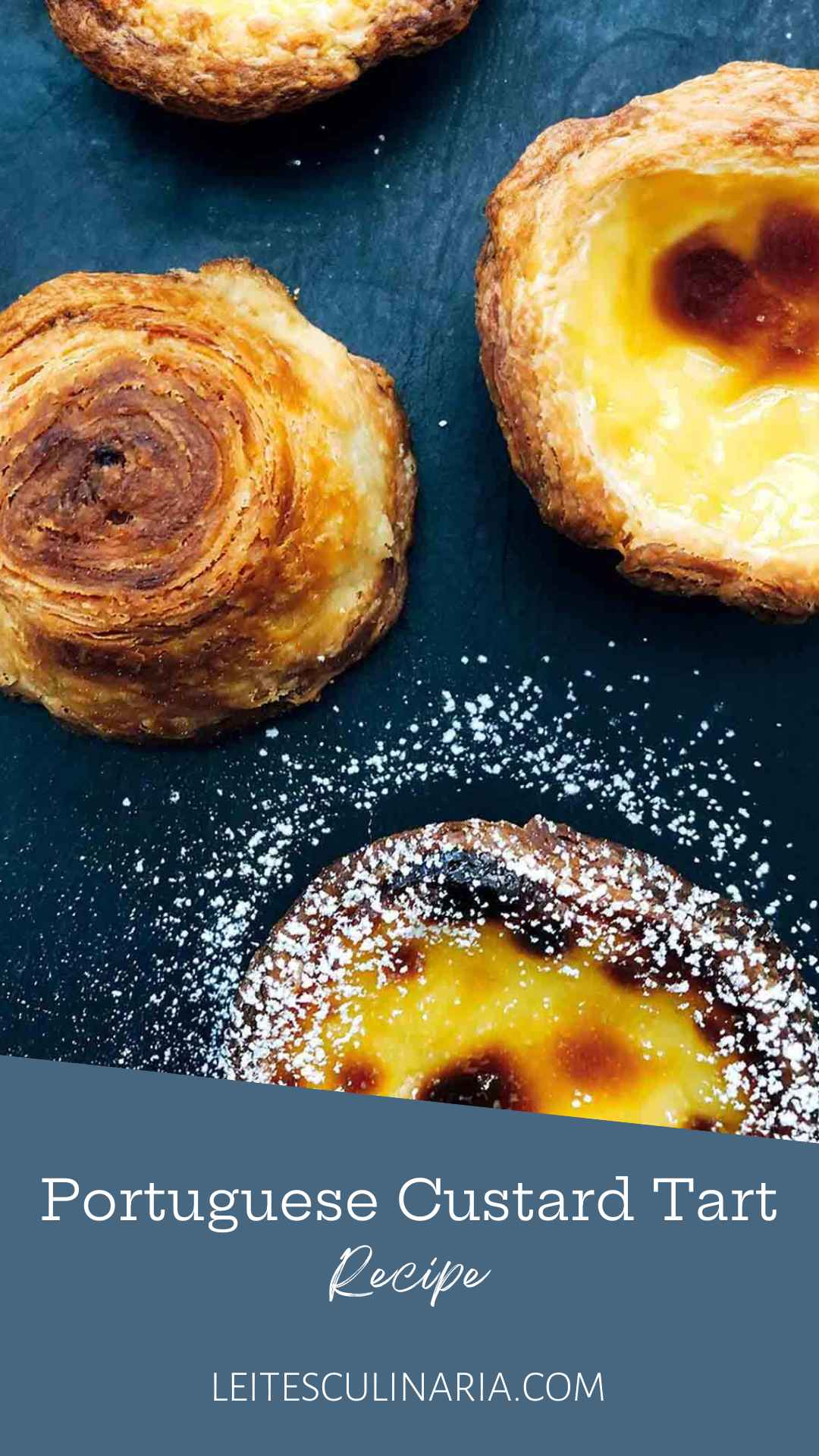
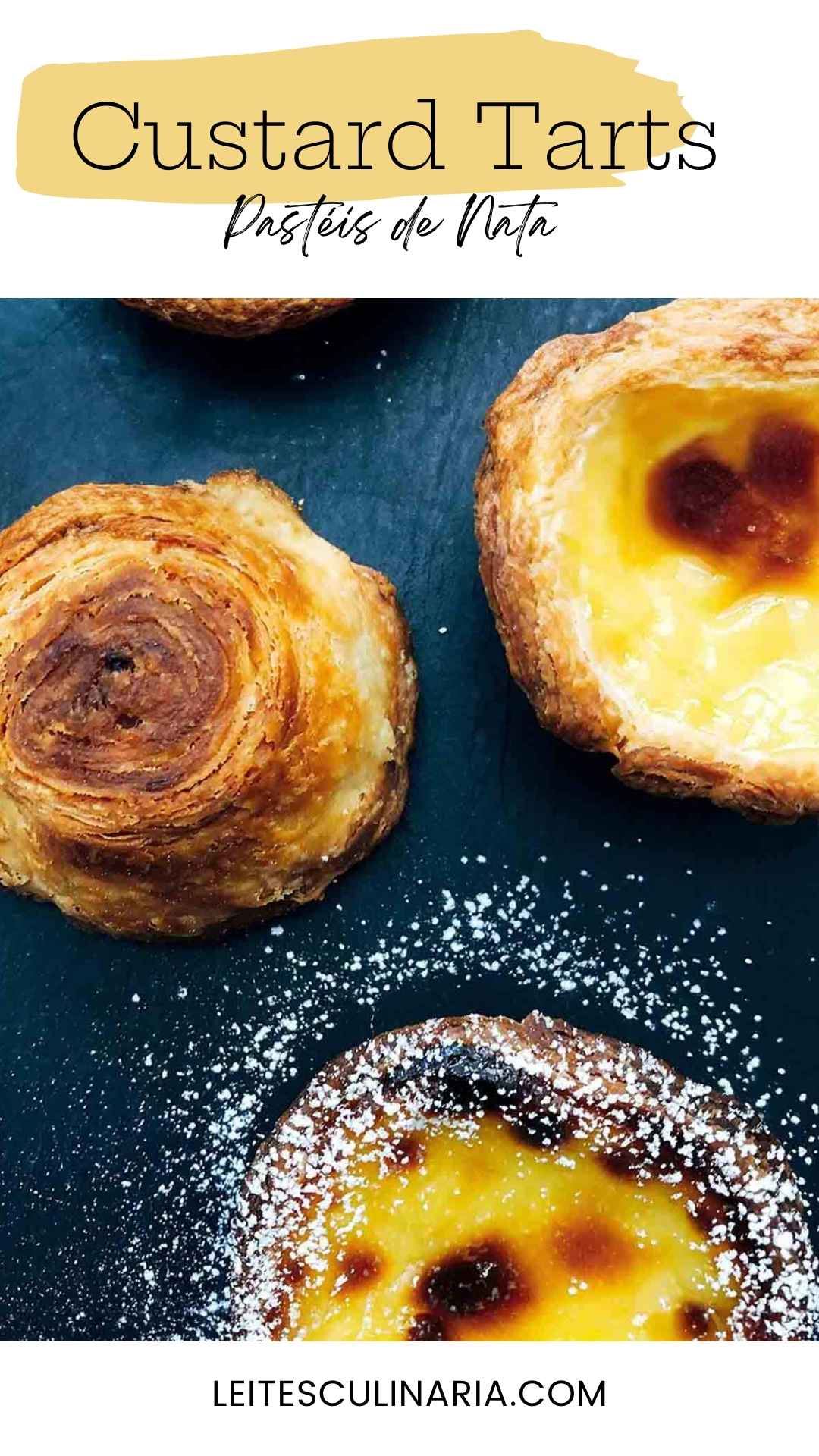
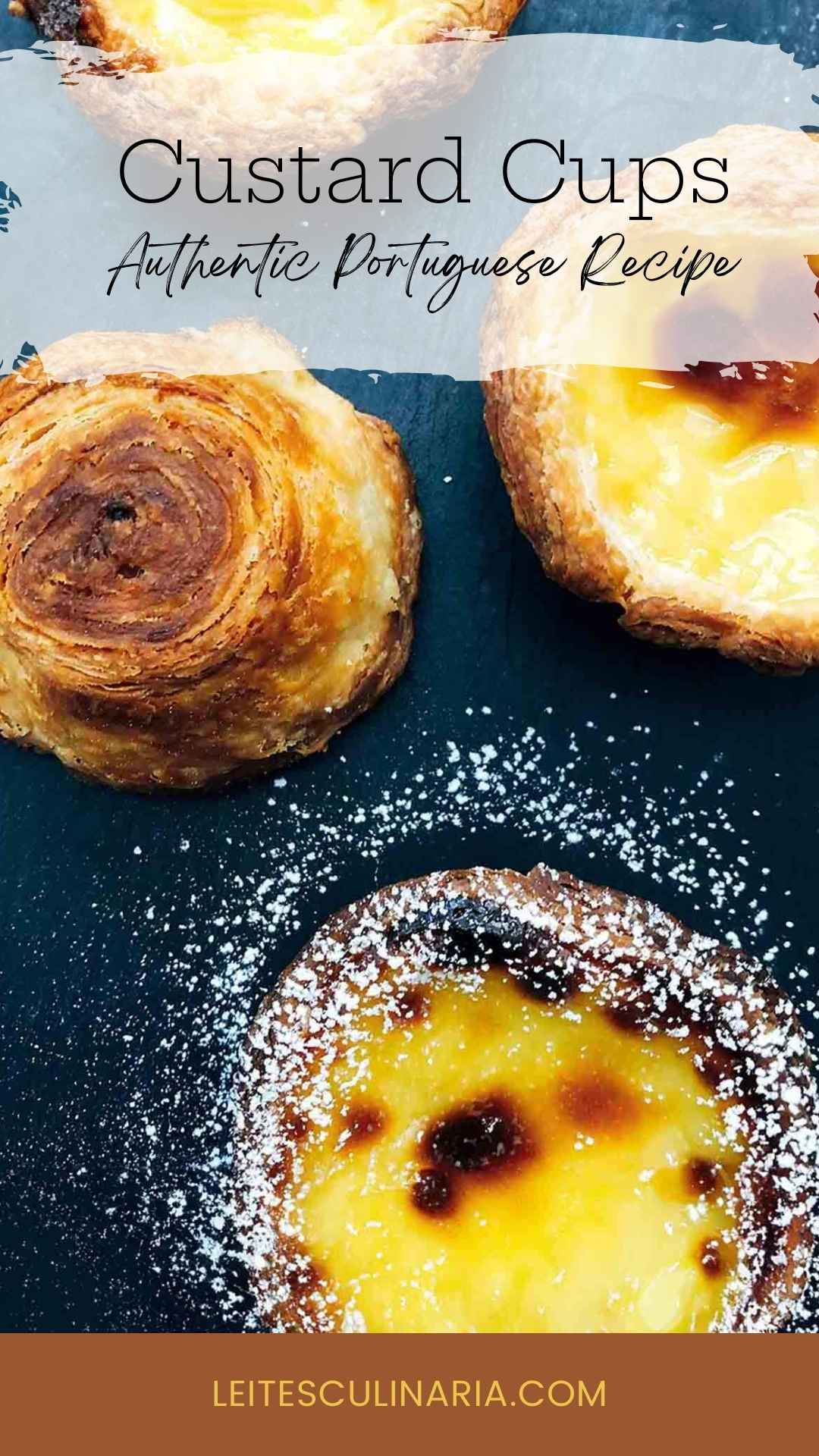










Hi David,
I’ve loved these lil treasures from a few years ago when travelling in Portugal.
Thanks for this recipe I’ll be trying these out this weekend.
Cheers Carl
Hi David Leite,
By any chance is you book translated in to Portuguese?
I would love to have it.
Thank You
Mariana
Hi, Mariana, no the book is only in English at the moment. I don’t think they are plans to translate it.
Hi Ivan,
I can translate to Portuguese for you if you need. Just send material. I will love to cooperate. No charges at all.
Happy Thanksgiving
If that isn’t the Thanksgiving spirit, Simoneti, I don’t know what is. Many thanks…
This recipe is the real deal and not too complicated. They taste exactly like the ones served up at the Lisboa Patisserie in Notting Hill, London. My only observation is that based on a standard sized muffin tin you’ll only get 24, otherwise great!
Hi Ivan, the recipe calls for mini-muffin tins. So if you used a standard size, I think you’d get about 20 or so. You’d also need to bake them longer, too,
I tried to make the tarts with the pastry I bought at supermarket. It didn’t come out quite right. The bottom of the tart seems not baked properly. It turned soggy after it got cold. Not crispy and flaky anymore. Is it because of the dough?
ron, most likely. The dough needs to be almost quite thin, especially if your using commercial pastry. I find store-bought dough to be too elastic. If you try it again, make sure to make the dough very, very thin and prick it with a fork on the bottom of this tin form. This prevents the dough from puffing up, which will keep it crisper.
I had the same problem using puff pasty, then my Portuguese friends told me they use filo dough with a brushing of butter between the layers…it seems to work great.
Antonio, yes, phyllo dough will work, but it’s not traditional. Still, any dough in a storm!
Have a video on this?
Mia, sorry no video on this yet. It’s on my to do list…..
Hi! I made it today but it’s soggy before baked 🙁 why?
Lo, what was soggy? Everything is raw, so it should be soggy.
I mean the puff will shrink before it cooked :(. The filling was spilled out.
Lo, I see. It could be many things. The dough might not have been pulled all the way up the sides of the tin. Or the dough might not have rested enough. Or even the slice you cut may not have been thick enough. I will agree, this is a tricky recipe.
So I’ll give you a play be play of what happerned:
1. Made The Recipe exactly as it said
2. We started baking the tarts, looked fine
3. It starts smoking up HORRIBLY
4. Smoke Detectors go off BEEP! BEEP!
5. We are trying to get smoke out
6. Fire department comes, we tell them what happened they leave.
7. While trying to clear the smoke detectors, we set off the burglar alarms
8. Police come, we tell them what happened
9. They leave
10. We tell others about this disaster
The smoke came from the 2 STICKS of butter that boiled over, be careful if doing this recipe, or use less butter than recommended.
Bremer, my that sounds dreadful! How high was your oven? The 2 sticks of butter is correct, and while smoking can sometimes happen, I’ve never heard of the butter boiling over! I’ve made these countless times and never had that happen. Did you perhaps put too much dough in each tin?
maybe.
I also had some butter spillover and solved the problem with a baking dish full of water placed under the mini muffin tin–as the butter boiled over, it dripped into the water and didn’t smoke. It seems to have made the cook time a bit longer but worth it for a non-smoky kitchen.
(I’ll try it with less dough next time.)
Great idea, Emma! It cooked longer only because it took more time to heat up due to the water. I’d suggest filling the baking dish with only 1/2 inch of water and placing it on the rack underneath, giving space for hot air to circulate.
I am super excited to try these. What changes would I need to make if I wanted to make the full size versions? I assume the filling recipe would remain the same but the size of the pastry log would have to be altered, as would the baking time. Would you be able to tell me what these changes would be?
Thank you so much for your time.
Hi, John. It really depends on what “full size” means. Will you be using the pastéis tins that they use in Portugal or a muffin tin? What I would do is cut a wider slice from the dough log. Press the slice in the tin/muffin tin as specified in the recipe. You want it to come all the way up the sides and extend beyond the top lip by 1/16th to 1/8th of an inch. Once you know how much dough you’ll need to do that, cut the remaining slices the same size. You’ll have to bake the pastries longer; again that has to do with how much larger your tins are. I would check every 2 minutes or so after the initial 8 minutes. They should be just cooked through; they’ll continue cooking as they cool. Hope this helps.
Thank you for the quick reply. I apologize for not being clear; however, I was referring to regular muffin tins. I would love to have the proper pastéis tins and will look for them in the near future. I will definitely experiment with the width of the pieces cut from the dough log and keep an eye on the time.
Time permitting, I’ll attempt to make these on the weekend and report back!
Hi John. With a regular muffin tin, you don’t want to go all the way up the sides, as it makes the pastéis too big. Go a little more than halfway up. Now, if your tin is nonstick, it will be hard to prevent it from sliding down as it bakes and the custard spilling out. As far a baking, I’d try 10 minutes and then check it.
Thanks again for the tips! Sorry, forgot to ask earlier…
When I roll out the pastry log, should it still remain an inch in diameter and 16 inches long or should it be slightly thicker than an inch (perhaps 1.25 inches) since the regular muffin tins have a wider base than the mini ones? Not sure if that makes any sense.
I am pretty much a beginner so please excuse what might seem like a dumb question but they actually sell muffin tins that don’t have the nonstick surface? I assumed they were all nonstick.
John, not a problem. All you need to do is cut the log in to wider slices. That will give you enough dough to work with.
Older muffin tins are no stick. The mini tins I use are nonstick, but the wells are so small, I can kind of anchor them to the rim.
My suggestion for success is to bake off 2 or 3 of them as a test. Then make any adjustment you need in the size of the slice and cooking time.
David, you have been a tremendous help. Thank you for your patience and taking the time to answer all my questions. I truly appreciate it.
John, my pleasure. Now march into that kitchen and bake away!
The oven setting at 550 degrees Farenheit is a mistake. I tried the recipe–followed it completely and burned the bottoms and most of the sides. I checked online and 200 degrees Celcius translates to about 400 degrees F. I’ll try again but will reduce the temperature.
Luisa, I’ve never had a problem at that temperature. This is the first I’ve hear of it. Are you using the correct size pan–the mini muffin tin? It needs high heat in order to cook quickly and thoroughly. If you’re using full muffin tins (or larger tins), it could burn. Also, do you have an oven thermometer? Your oven might be running hot. Last, are you using convection or regular heat?
David, should the oven rack be in the center or bottom rung of the oven, to avoid burning?
Maria, I actually place them in the upper third, as you want to get the little burn marks on them. But if they’re browning too quickly, cover with foil and set the next batch on the center rack.
I fell in love with these pastries in Portugal so was excited to find this recipe. I just baked them and at 550, the pastry burned and the custard ran all over the pans. I will try these again only baking at 450. I also thought the custard seemed a little sweeter than I remember. Also, when you make the custard it is very runny and I thought maybe I’d made a mistake. It appears to have thickened as it cooked, what didn’t run all over the place.
Sharon, how close were the pastries to the top of the oven? That can affect things. (Is 550° in your oven automatically broil?) Is your oven calibrated? Was it the pastry shrinking back or the custard spilling that was the problem? And last question: we’re you using a mini-muffin pan or a larger size? This recipe does have a running raw filling, but it does firm up when cooked.
These little gems are really tough to make at home–trust me, I know!
Hi David, thanks for your reply. I must apologize for commenting before I tasted the little pastries. First of all, yes the custard is runny and sweet, but after baking it sets up perfectly and isn’t too sweet when you bite it with the unsweetened pastry. Secondly, I did cheat and tried using premade puff pastry and rolled it out and followed your directions. I put the pastry in the tins and then wasn’t able to bake until the next day. I didn’t smoosh the pastry in the tins until it was thin enough and even at 550F, they didn’t get done on the bottom and didn’t hold enough of the filling. Since the pastry was too thick, it probably puffed up too much and spilled a lot of the filling out. Didn’t stop us from eating them though. I cooked the leftover filling on top of the stove and have been sneaking it a spoonful at a time from the fridge 😀 I definitely will try them again using your dough recipe. I was trying a short cut and had an epic fail . . . no fault of your recipe!
Hey Sharon, well THAT explains it! Commercial puff pastry is much different from this dough, even though they’re both laminated doughs. When you use the dough in the recipe, it’s literally less than a 1/16 of an inch in places, so it doesn’t puff the same way. If you want to use commercial dough, make sure to 1.) make it thin enough, and 2.) dock it by pricking it with a fork. It helps prevent from puffing too much.
Hello David,
I am planning on making these for Christmas, and was wandering if you had the metric conversions of your measurements. I don’t mind cups, but “spoons” do throw me. Thank you.
Maria, I don’t, I’m sorry. But I find this site helpful.
Hello, David!
I just viewed the Delicious Destinations show highlighting Lisbon, and the section of the show dealing with these little gems specifically said they are baked at 400 degrees.
Cynthia, thanks for writing. I’ve heard all kinds of temperatures for this recipe! When I’ve baked them at 400 degrees, they don’t come out right. And I know when I grilled the owner in Portuguese, he said it was 400°C, which is approximately 750°F–which would incinerate them! I could see 400°F in a powerful convection oven, though.
I have a wood oven (commercial bakery) and I am really looking forward to baking these pastries in it – easily able to obtain temperatures over 500F – what temperature would you recommend? Will try to use a standard sized muffin tin as this size suits the tastes of my customers more closely.
Dianne, I would try 500/550 degrees to start. There might be adjustments that need to be done for commercial production. As I’m a home cook, I couldn’t tell you what they are!
Hi David,
Thanks for the recipe. Can you clarify what is meant by the following, after trimming uneven edges? What is a dot?
4. Brush excess flour off the top, trim any uneven edges, and using a small offset spatula dot and then spread the left two-thirds of the dough with a little less than one-third of the butter to within 1 inch of the edge.
Grace, certainly. What I mean (and I will clarify it in the recipe now) is to drop pieces of butter all over the dough. It makes it easier to spread it that way, rather than trying to plow through a big hunk of butter.